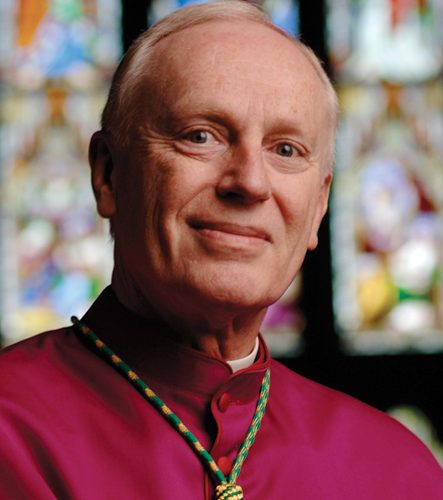
Past Bishops
Bishop McCloskey – The First Bishop of Albany
John McCloskey 1847 – 1864
John McCloskey was named the first Bishop of the newly erected Diocese of Albany by Pope Pius IX on May 21, 1847. He was formally installed by Bishop Hughes on the following September 19. At the time of his arrival, the Upstate New York diocese covered 30,000 square miles (78,000 km2), containing 60,000 Catholics, 25 churches, 34 priests, 2 orphanages, and 2 free schools. McCloskey first selected St. Mary’s Church as his episcopal see but it soon proved unsuitable, leading him to construct the Cathedral of the Immaculate Conception, whose cornerstone was laid in July 1848 and dedication took place in November 1852.

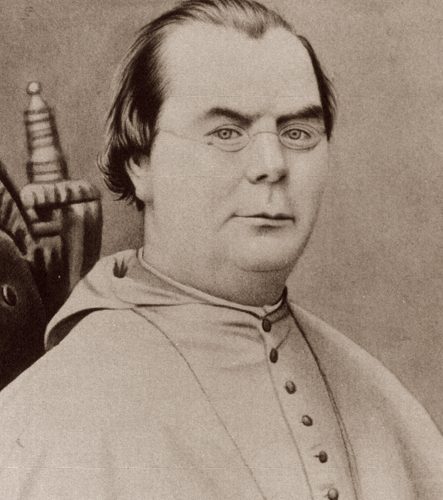
Bishop Conroy – The Second Bishop
John J. Conroy 1865 – 1877
John McCloskey was succeeded as Bishop of Albany by his Vicar General of the Diocese Father John J. Conroy, who also served as Pastor of St. Joseph’s Church in North Albany, another Patrick Charles Keely design. In October 1865 John Conroy became the first person to be consecrated a bishop in the Cathedral and was installed as Albany’s second Bishop. Bishop Conroy refined the quality of education and expanded the diocese building on McCloskey’s foundations. Bishop Conroy created 59 new parishes, many schools and established St. Peter’s Hospital. In 1877 Bishop Conroy resigned due to poor health. He lived out his remaining days in New York City, until his death in 1895. After his funeral in the Cathedral his remains were interred in the crypt.
Bishop McNierney – The Third Bishop
Francis J. McNierney 1877 – 1894
Bishop Conroy was succeeded by his Coadjutor Bishop, Francis J. McNierney who in 1872 had been appointed to assist the ailing Conroy, as coadjutor bishop with the rite of succession. McNierney had served as Archbishop McCloskey’s secretary. For five years, McNierney actually administered the daily operation of the diocese. Upon Conroy’s resignation, Bishop McNierney, without ceremony, (in his own words) “ walked from the sacristy to the throne”. Under Bishop McNierney the growth of the Diocese continued and the Cathedral of the Immaculate Conception entered a period of Renaissance that would continue for nearly forty years. Mc Nierney himself a superb baritone, established a world-class choir and music program.
The work of completing the Cathedral was resumed under McNierney. In 1887 the south tower was constructed under the supervision of a Mr. Jewel who had built the north tower twenty-five years before. On October 14, a cross-gilded with gold leaf was placed upon the tower spire. In 1891 both vestries were added and the enlarged sanctuary was completed. Stained glass windows gifted by individuals were placed in the clerestories, transepts and sanctuary. In 1892 the Cathedral was declared completed, luckily just one year before the Panic and Collapse of 1893. Bishop McNierney fell ill and died on January 2, 1894, having cast a large shadow over the Cathedral and diocese. He was the first of Albany’s bishops to be buried in the Cathedral crypt located below the high altar.
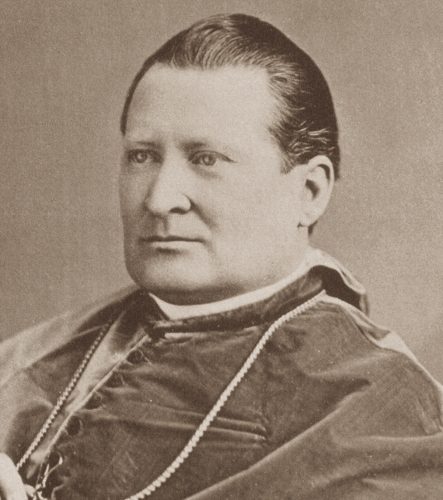
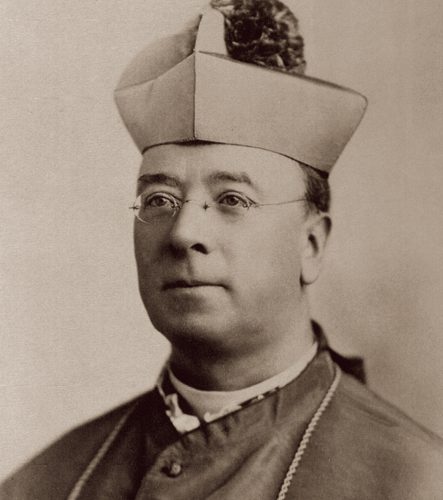
Bishop Burke – The Fourth Bishop
Thomas Martin Aloysius Burke 1894 – 1915
Father Thomas Burke, pastor of St Joseph’s Church succeeded Bishop McNierney in 1894, becoming the fourth Bishop of Albany. Bishop Burke traveled to Rome in 1895 to make an “ad limina” visit to report on the progress of the Diocese to the Pope. Bishop Burke presented the Pope with a famous doctored photograph of himself standing mitered in pontifical robes at his throne in the Cathedral sanctuary surrounded by all the priests of the diocese. Many of the great treasures of the Cathedral were acquired in the reign of Bishop Burke. Burke acquired the great stained glass window “ the Last Judgment” from Hardman & Co of Birmingham England as his personal gift to the Cathedral. It was installed in 1897 in the south transept. Bishop Burke also gave the Stations of the Cross, which had been awarded a gold medal at the Paris Exposition of 1897. The Chancel Stalls with marvelous gargoyles, purchased by McNierney and carved by Goyer of Belgium were installed in 1894. In 1902 stained glass windows from Hardman for the main body of the Cathedral and the magnificent oak pulpit carved by Stolzenburg in the Netherlands were installed. In 1902 the Cathedral, celebrating its golden Jubilee, was consecrated by Bishop Burke. In 1915 Bishop Burke died at age 75 years and was interred in the crypt. His final gift to the Cathedral was a handsome sanctuary lamp which burns to this day.
Bishop Cusack – The Fifth Bishop
Thomas Cusack 1915 – 1918
Bishop Burke was succeeded by the Most Reverend Thomas Francis Cusack Auxiliary Bishop of New York. Bishop Cusack had the shortest reign of Albany’s Bishops. Upon America’s entry into the war in 1917, Bishop Cusack put the resources of the Diocese at the disposal of the government and did much to advance the number of chaplains for the armed services. He also organized missions for the more remote precincts of the diocese. Bishop Cusack frequently conducted often-humorous question & answer sessions with the Cathedral congregation. He became a familiar, friendly face on the streets of the city, walking block after block, meeting people one on one.. During his tenure Bishop Cusack added electric lights throughout the Cathedral. Before that 1,124 gas jets illuminated the church. The Bishop also added marble flooring to the main and side aisles. He gave a significant sum of money to the Cathedral to defray the cost of these improvements. Sadly, in January 1918 the popular Bishop fell ill with cancer and died at the old Bishop’s residence on Madison Ave. the following July at the age of fifty-six. The much-mourned Bishop Cusack was interred in the Cathedral crypt.
Perhaps the greatest accomplishment of his brief tenure was the establishment of Catholic Charities, which continues to this day as the major social service arm of the diocese.
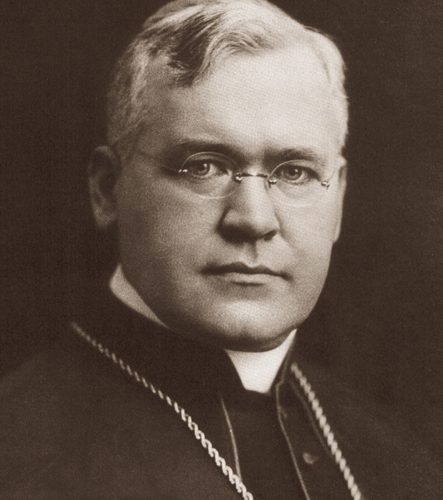

Bishop Gibbons – The Sixth Bishop
Edmund F. Gibbons 1919 – 1954
On April 1, 1919 Father Edmund Francis Gibbons, pastor of St. Theresa of Avila Church in Buffalo NY, was installed by Archbishop Hayes of New York as the Sixth Bishop of Albany. Gibbons who followed the brief reign of Cusack, served for thirty-five years becoming Albany’s longest tenured bishop to date. With Bishop Gibbons’ appointment, the modern era of the Roman Catholic Diocese of Albany began. New grammar and high schools, hospitals, nursing homes, parishes, Mater – Christi Seminary, Siena College, the College of St. Rose, the Diocesan newspaper, The Evangelist; all were just some of Gibbon’s legacies. The Cathedral in those years flourished as a parish church, and was at the center of the burgeoning diocese. Under Gibbons the Diocese continued to expand through the Great Depression and the Second World War. He welcomed many dignitaries to the Cathedral, including prelates, Presidents and Governors. Governor Al Smith was of course a next-door neighbor of the Cathedral and Chancery. The “Happy Warrior” and his family were active members of the Cathedral parish. “Smilin Al” and Bishop Gibbons were great friends and consulted each other regularly. In 1954 Gibbons retired in favor of his Coadjutor Bishop, William Scully. Bishop Gibbons died in 1964. and was interred in the Cathedral crypt. His tenure had a profound impact on the diocese and New York State.
Bishop Scully – The Seventh Bishop
William A. Scully 1954 – 1969
William A. Scully, Coadjutor Bishop of Albany since 1945 succeeded Bishop Gibbons and was installed as the seventh Bishop of Albany in 1954. Bishop Scully was a talented administrator who previously headed programs of the Archdiocese of New York. Scully continued to improve and expand the diocesan school system and streamlined various institutions and programs within the diocese, Bishop Scully was active in improving race relations and advocating better housing and work conditions for minorities. During Bishop Scully’s time the diocese’s suburban population grew large as the inner city parishes began to dwindle. The 1960s began an era of profound change for the City of Albany. With the construction of the South Mall under Governor Rockefeller, the Cathedral parish lost a majority of it’s congregation The entire neighborhood bordered by Madison Ave. State Street, Grand Street and South Swan St. was demolished to make way for what we now call the Empire State Plaza. For ten years the Cathedral withstood the massive excavation, blasting and construction that occurred next door, a tribute to Patrick Keely and all who built it. In the early 60s Bishop Scully became ill with Alzheimer’s disease. In 1957 Monsignor Edward J. Maginn, was appointed Auxiliary Bishop to Scully. In 1966 Maginn was appointed Apostolic Administrator and served until Bishop Scully died in 1969. Bishop Scully was the last bishop interred in the cathedral’s crypt.
Bishop Maginn – Auxiliary Bishop
Edward J. Maginn 1957 – 1984
Bishop Edward J. Maginn may be best known for his role as Auxiliary Bishop to Bishop Scully; however, he served the diocese faithfully for many years prior. Soon after Bishop Gibbons ordained Maginn at the Cathedral of the Immaculate Conception in Albany in 1922, he appointed him Vice Chancellor for the Roman Catholic Diocese of Albany’s. Appointments to Chancellor and Vicar General followed in 1924 and 1936, respectively. The people of St. Vincent de Paul parish in Albany welcomed then-Father Maginn as their pastor and principal of Vincentian Institute in 1944. In 1957, Bishop Maginn was consecrated as Auxiliary to the Bishop of Albany and Titular Bishop of Curium by Bishop Scully. He was named Apostolic Administrator in May 1966, and carried out those responsibilities until Bishop Scully’s death in May 1969. Bishop Maginn helped shepherd the Diocese through the turbulent 1960s, with special attention to the pastoral, educational, and healthcare institutions placed under his leadership. He served as one of the Council Fathers, and attended the Second Vatican Council in Rome. Bishop Maginn was appointed Vicar General by Bishop Scully’s successor, Bishop Broderick, in 1969; that appointment was renewed in 1977 by Bishop Hubbard. Bishop Maginn served the parishioners of St. Vincent de Paul until his retirement in 1972. He died on August 21, 1984, and was interred at St. Mary’s Cemetery, South Glens Falls.
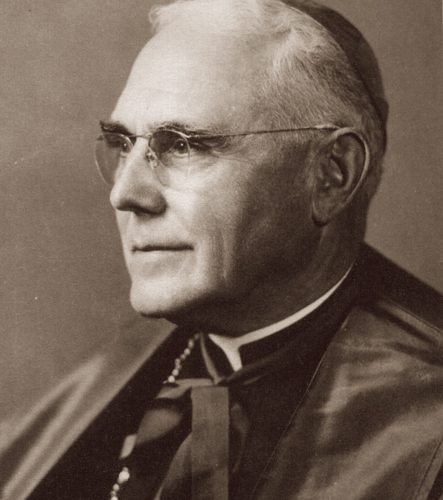
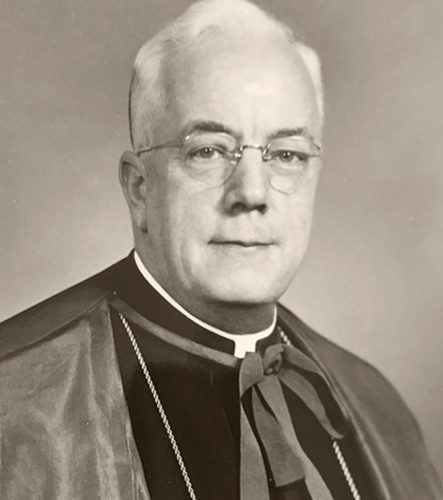

Bishop Broderick – The Eighth Bishop
Edwin B. Broderick 1969 – 1976
Bishop Edwin B. Broderick succeeded Bishop Scully and was installed as the eighth bishop of Albany in 1969. In addition to teaching and pastoral work, Bishop Broderick served as Director of Radio and Television and later as Auxiliary Bishop in the Archdiocese of New York. As director of television he produced programs for Bishop Fulton J. Sheen. Broderick was the first Bishop of the post Vatican II diocese and did much to further the spirit of ecumenism. In 1974 he welcomed to the Cathedral the Archbishop of Canterbury Michael Ramsey. Bishop Broderick extended a greater role of participation to the laity. Inner city parishes including the Cathedral became urban centers for social service, serving a multi – denominational population in need. In 1976 Bishop Broderick was chosen as Director of Catholic Relief Services, the US Catholic overseas aid agency and resigned as Bishop in 1976.
Bishop Broderick served as Bishop Emeritus in his retirement and often traveled back to his Diocese to assist with confirmations and other celebrations. Bishop Broderick died in 2005.
Bishop Hubbard – The Ninth Bishop of Albany
Howard J. Hubbard 1977 – 2014
On March 27, 1977 Father Howard J. Hubbard was ordained to the episcopate and installed as the ninth Bishop of Albany by the Archbishop of New York, Terence Cardinal Cooke. The joyous ceremonies of that day were not held at the Cathedral, but at Siena College to accommodate the large crowd. All present sensed they were witnessing an historic moment; the beginning of a new and exciting chapter in the history of the Albany Diocese. Applause and cheers filled the auditorium as the new Bishop took his place upon the Cathedra. Hubbard’s appointment was greeted with enthusiasm. Born in Troy, and schooled in the capital district, Bishop Hubbard was the first native son of the diocese to become Bishop. He had earned the title “Street Priest” for his work in poor and troubled neighborhoods in Albany and was the founder of Hope House, the renowned center for drug rehabilitation. Bishop Hubbard has charted a dynamic course of growth and modern day ministry, promoting social service, social justice, education and ecumenism.
During Bishop Hubbard’s tenure, the Cathedral has witnessed historic events. At the Cathedral on Palm Sunday, March 19,1989, Bishop Hubbard took part in the world’s first reconciliation service between Jews and Catholics. Over 1,000 people representing the Jewish and Catholic faith, gathered at the Cathedral for the historic service. A sculpture entitled “ Portal ” commemorating the event was dedicated at the Cathedral by the Bishop and Rabbi Martin Silverman.
In 1997 Bishop Hubbard presided over the Sesquicentennial Year of the Diocese, beginning in a grand day of celebration at the Cathedral attended by clergy and laity from across the diocese and the country.
